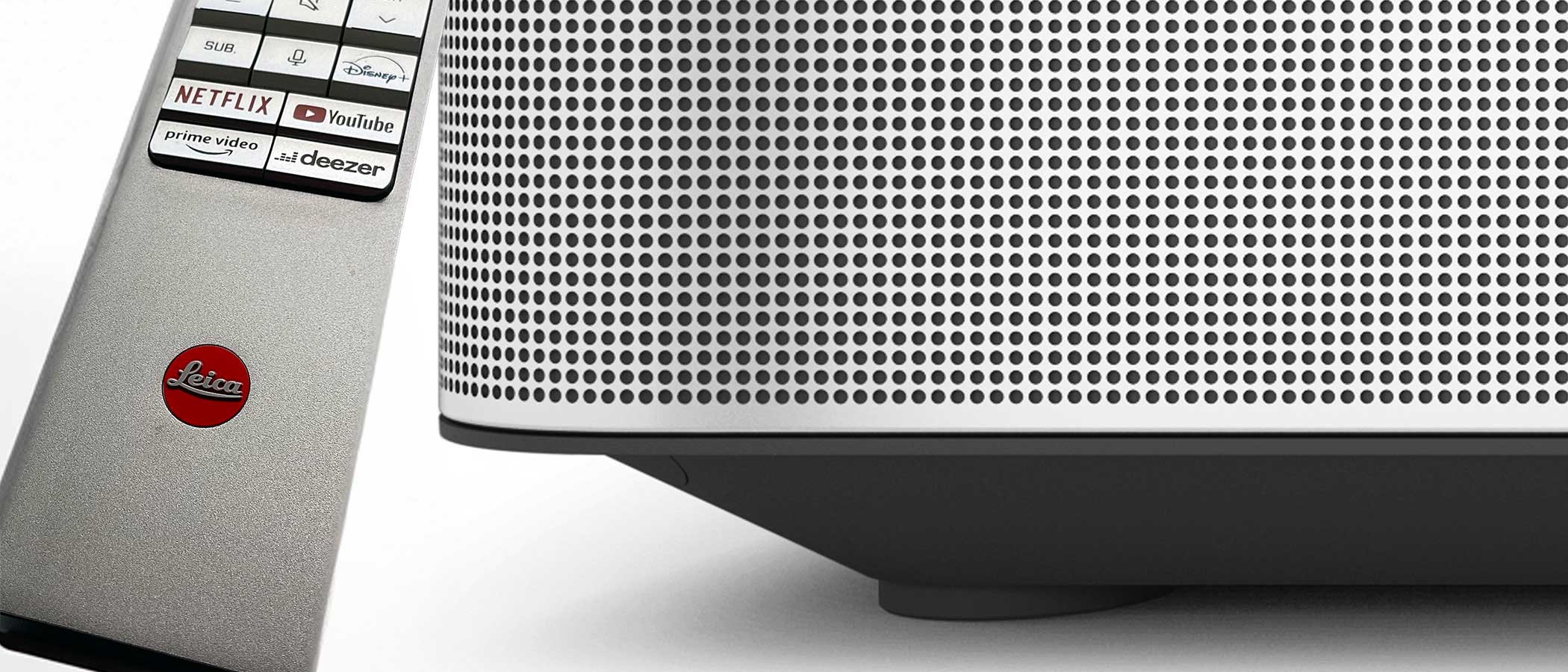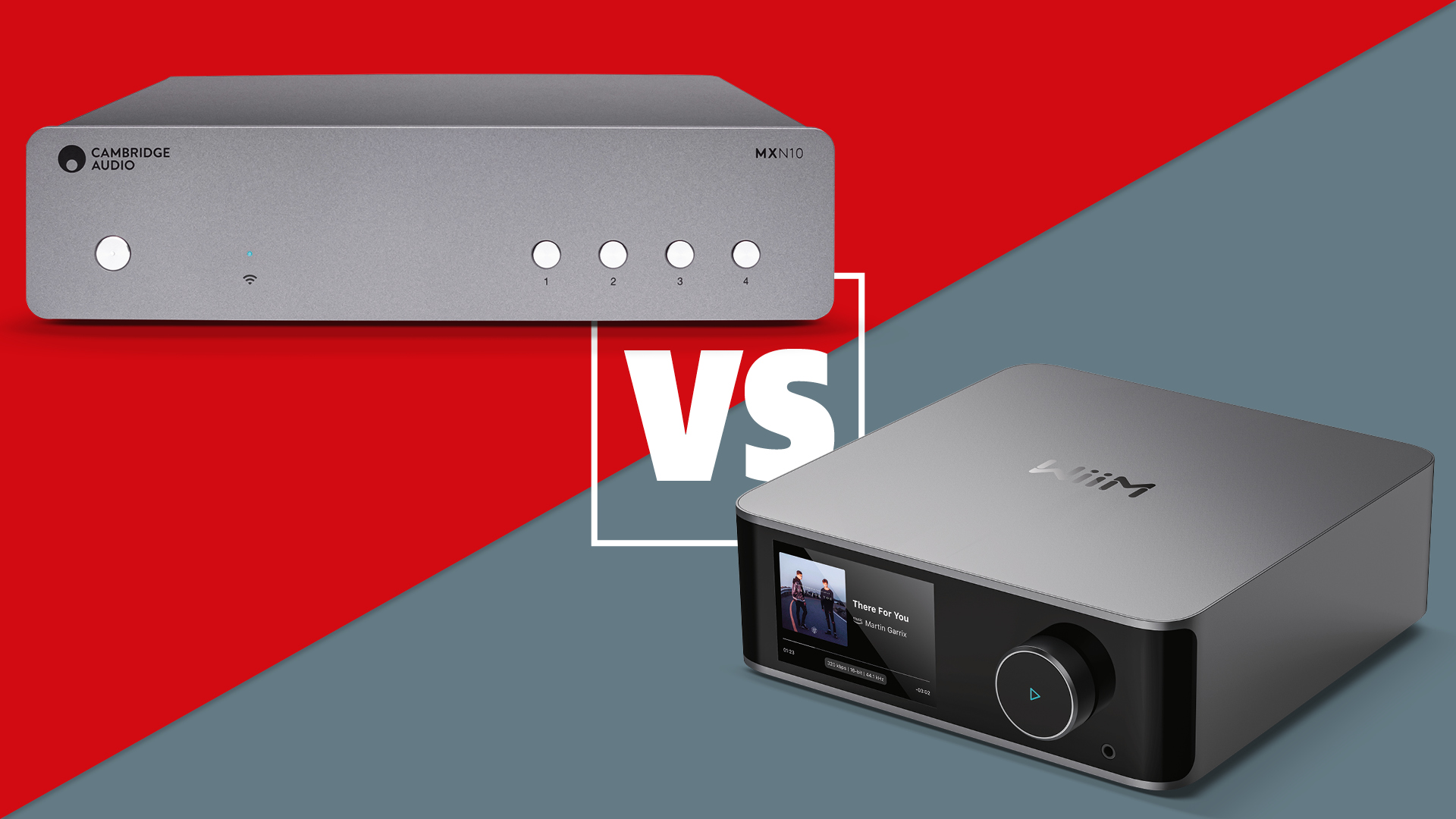Sound+Image Verdict
The consumer ultra-short-throw projector category came of age once they were reimagined as a TV replacement, with streaming dongles and built-in speakers. Hisense took the idea to another level with its Laser TVs, and now Leica has taken those Laser TVs to another level, principally by upgrading the lenses, but also the look, creating a premium product which we reckon will attract higher-end buyers as much with its gorgeous product design as with its performance, which is pretty thrilling, even overcoming a good whack of ambient light, though reaching its best performance in a darker room.
Pros
- +
Excellent image quality…
- +
…right across the screen
- +
Gorgeous box
- +
Full TV replacement
Cons
- -
PVR functions limited; single tuner not triple
- -
Price vs competitors
Why you can trust What Hi-Fi?

This review originally appeared in Sound+Image magazine, Australian sister publication to What Hi-Fi?. Click here for more information on Sound+Image, including digital editions and details on how you can subscribe. Read What Hi-Fi?'s global, star-rated Leica Cine 1 review.
When we think of design icons in hi-fi and AV, we might turn first to Denmark, or perhaps the US, UK and Japan.
But if you ask a photographer the same question, it’s more likely to be Germany, and specifically Wetzlar, home to Leica Camera AG, makers of legendary cameras since Oskar Barnack at Leitz (as Leica was officially called until 1986) came up with the first commercially successful 35mm still camera. Since then, a full century has seen Leica delivering the finest, neatest and most famous imaging devices on the planet: legendary, gorgeous, and considerably expensive.
Its lenses are a key part of the equation, Leica’s ability to deliver world-class glass has made its lenses legendary among photographers, and got Leica’s cameras on NASA’s shortlist for the space race. During John H. Glenn Jr’s triple-orbit mission on February 20, 1962, he used a Leica Ig camera to capture the first human-shot colour photographs of the Earth from space.
So who better to put their lenses into the projectors that bring bigscreen images back to the home? As Leica puts it, its business is “moving people through imagery,” and the Cine 1 allows it to deliver images to the living room as home entertainment.
Which is perhaps not too much of a departure for the company, if we step back a little in time. Photography has always been a form of home entertainment in itself, and in many 1960s and 1970s homes the biggest available imaging system would have been projection of 35mm transparencies mounted in slides, displayed up on a large square screen so much bigger than any available TV of the day that even the grainy Kodachrome family holiday pictures looked impressive.
Many was the home where this task was trusted to a stylish Leica/Leitz Pradovit slide projector, the height of home projection in its day, complete with a cabled remote control which allowed you to shuttle 35mm slide carousels across a smoky sitting room without even needing to put down the whisky tumbler.
Hence Leica sees the Cine 1 as representing its return to lean-back lounge entertainment. So welcome to ‘Cinema TV’, an ultra-short-throw projector with TV tuners, smart streaming, and a built-in sound system. You can plug in external sources, but the Cine 1 could provide everything you need in one: it’s a deliberate alternative to a television.
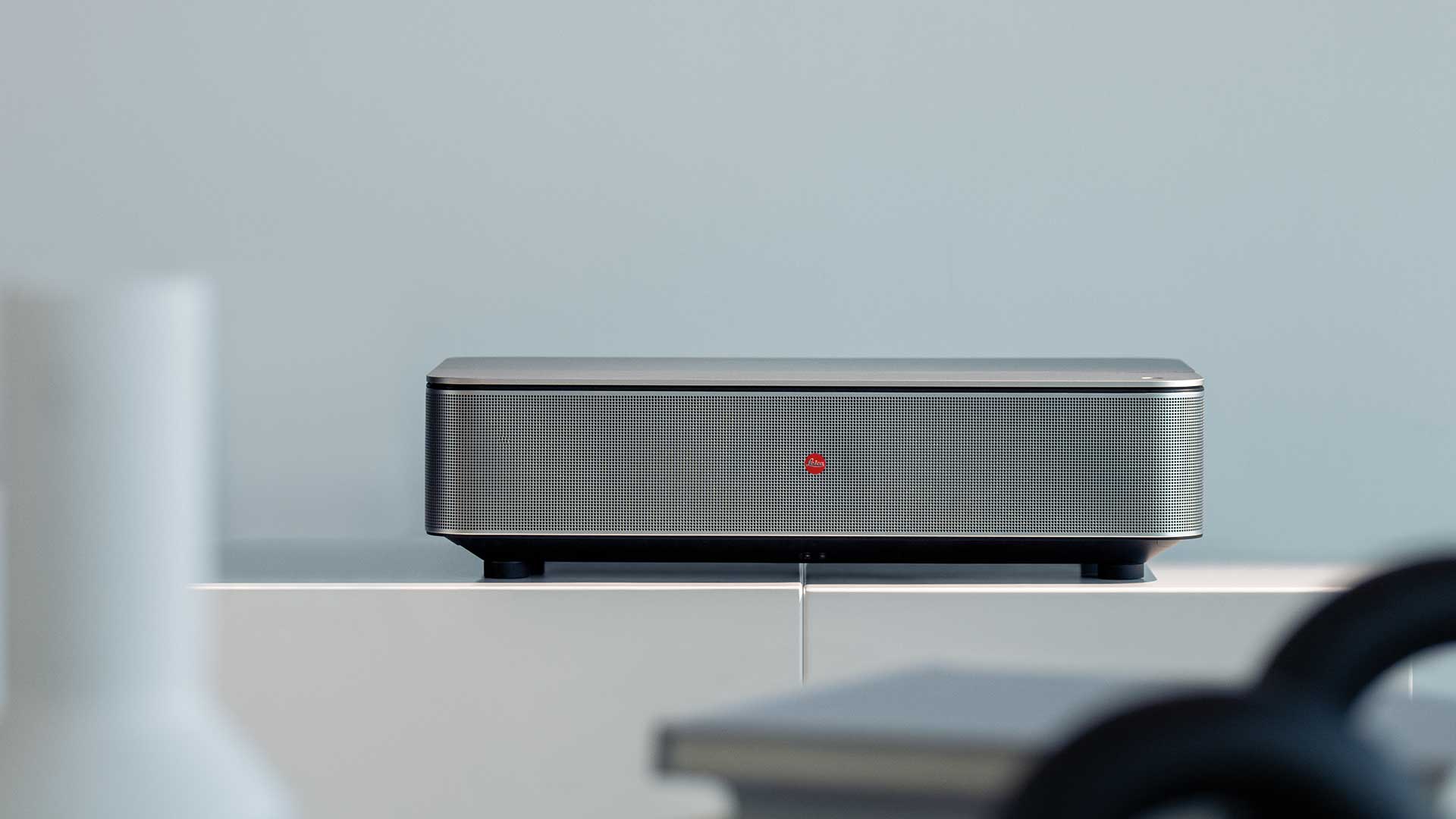
Not only that, it does so in style, with an instantly iconic exterior, looking functional but gorgeous, like the cameras – though the Cine 1 is four times wider than an SL2, at 60cm in width. The console really is so pretty that even if it did nothing at all we’d be happy to have its silver top surface motoring open and closed on command, that classic central red Leica dot central between its space-age Bauhaus curves. It’s just a stunner.
Even the remote control is many cuts above the pack. Here the red Leica dot sits near the bottom, above it a shining silver plane and then not a viewfinder or a flash-gun attachment, but a set of silver buttons, the top left inscribed in dark red with the logo for ‘Netflix’. It’s a collision between a classic past and a bold new future. Well, Netflix anyway.
Is it also expensive like a Leica? That depends on your point of view. In the consumer AV market the Australian pricing of A$13,999 for the 100-inch version and A$14,999 for the 120-inch is certainly above any comparable competitor. But in a catalogue shared by a Leica Watch ZM 2 Monochrom at A$23,900, or a ‘Leica SL2 Vario (camera) Christmas Bundle’ at A$15,599, the Cinema TV prices fall more into line. ‘If you want the best?’, they’re saying. It is, after all, a Leica.
To those Cine 1 prices you would be wise to add the price of a Leica-branded ambient-light-reflecting fixed screen, which is highly recommended both by Leica and ourselves, these currently selling for A$2690 for the 100-inch, A$3990 for the 120-inch, with other options available (see below for Australia, other markets may vary), and to consider the offers of installation as well.
Inside, outside
So the Leica Cine 1 sees the German company reclaiming home entertainment territory long ceded first to Japanese companies, then Korean, now Chinese. And it is with one of the current Chinese technology leaders that Leica has partnered for its return.
Initial announcements of the Cine 1 termed it a ‘Laser TV’; this has since evolved to ‘Cinema TV’, perhaps to disguise the partnership. But when it turns on and the screen doors open up to a VIDAA user interface, the connection with Hisense is clear. Hisense has already found success with this complete ‘Laser TV’ entertainment concept, so of course one must wonder exactly how much Leica has made this Cine 1 truly its own, and how much is primarily a recasing exercise. We asked Leica Australia’s Shaun McMahon that very question.
“So Leica with Hisense — it is a technology partnership, effectively,” he says. “We’re offering them a bit of guidance in terms of lenses, and they’re providing us with know-how in terms of the rest of the unit, including VIDAA. We’re not going to supply Leica Summicron lenses to Hisense, that’s where we stop short, but it is a collaboration.”
As noted, then, Leica has applied its own external design to make the Cine 1 look so lovely and luscious. But it’s Leica’s lenses that are very much the crucial thing here.
Ultra-short-throw is hard
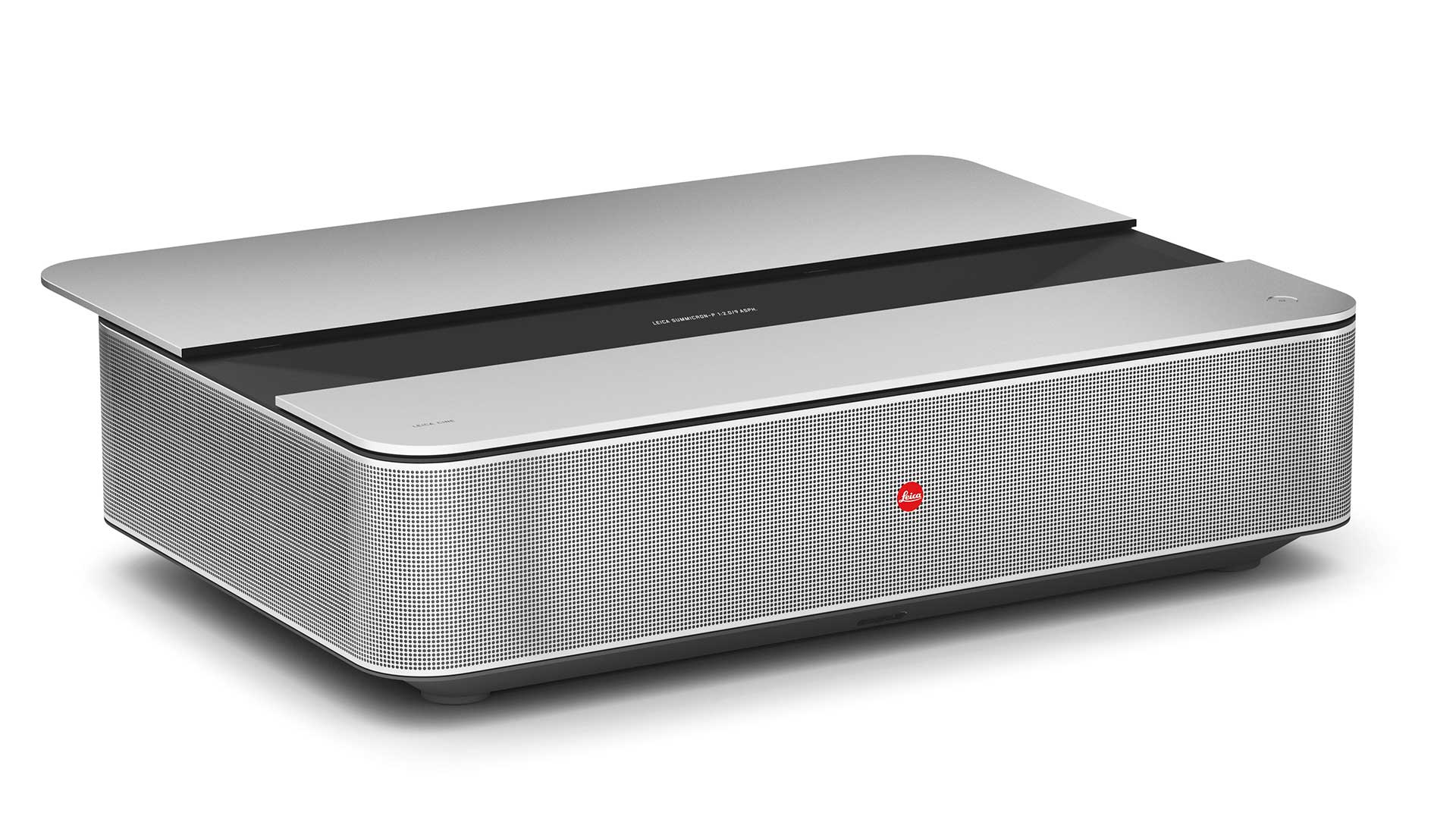
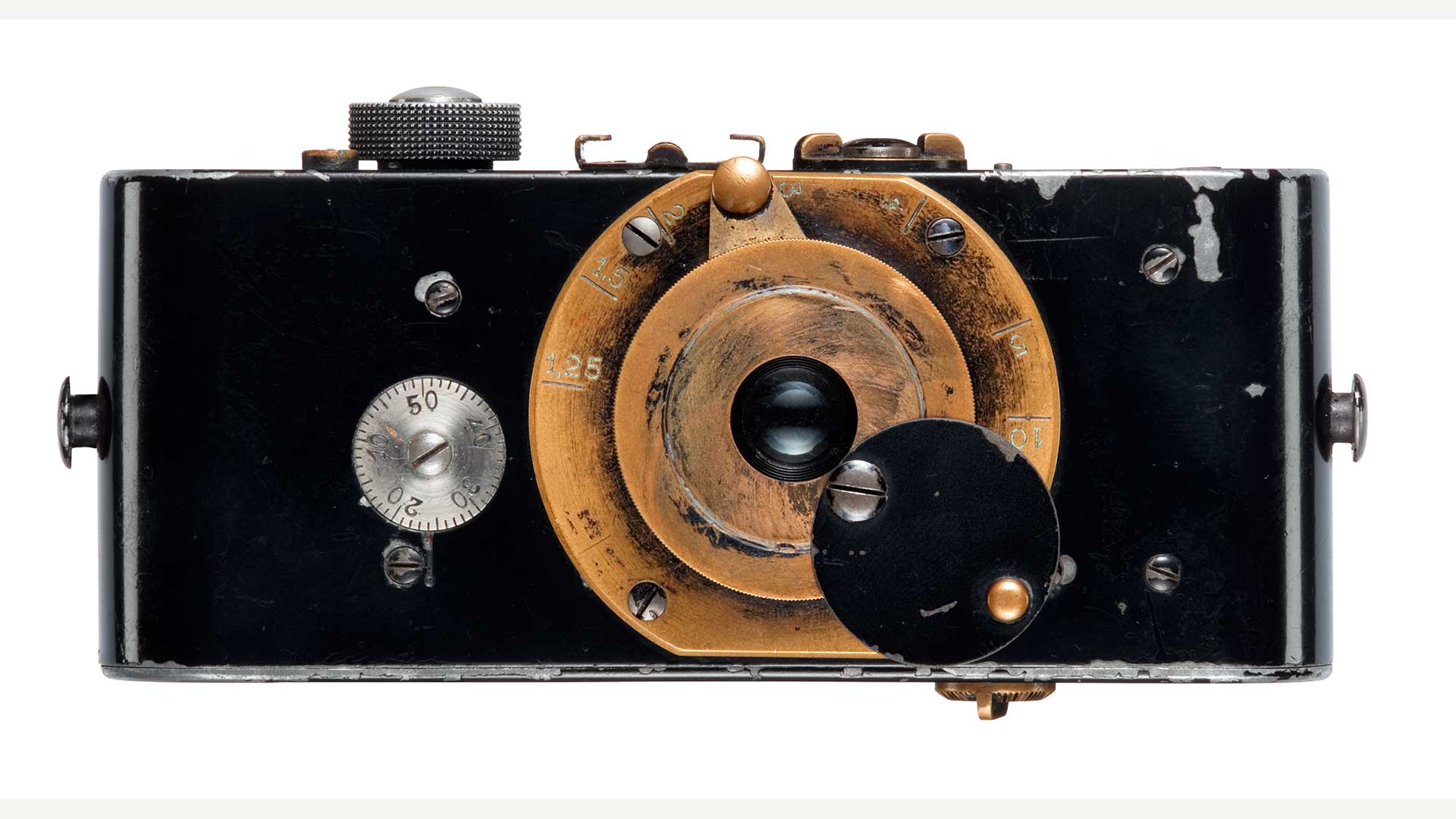
Back in 1849, a mechanic and amateur mathematician Carl Kellner established a small optical company in the German town of Wetzlar to make, firstly, telescopes and, later, microscopes. Known as the ‘City of Optics’, Wetzlar is in the German state of Hesse and about an hour’s drive north of Frankfurt.
In 1865, the company hired a talented optical engineer called Ernst Leitz, who impressed Kellner enough to be quickly made a partner. Just four years later, in 1869, he took over the whole operation, renamed Ernst Leitz Optische Werke. Leitz was just 27, yet his entrepreneurial prowess saw the business expand rapidly, and this continued under his son, Ernst Leitz II, who famously committed the company to building Oskar Barnack’s revolutionary compact camera (pictured). It was Barnack who originally came up with the idea of using 35mm cinema film as a standard for still photography, doubling the single-frame format from 18×24 mm to 24×36 mm. Unfortunately, Leitz senior never saw the prototype of the compact camera reach the production stage, as he died in 1920.
As an interesting aside, during the 1930s and 1940s, Ernst Leitz II and his daughter, Dr. Elsie Kuehn-Leitz, both Protestant Christians, arranged for hundreds of Jewish employees and their families to flee Germany and escape the Holocaust.
The company’s facility in the centre of Wetzlar continued to expand, but eventually it was decided to move the camera business to the nearby town of Solms, where it relocated in 1986. In the meantime, what had become the Leica Group subsequently split into three independents: Leica Camera AG (1996), Leica Microsystems and Leica Geosystems (1998). The latter two still operate from separate premises in the centre of Wetzlar, and Leica Camera has also since returned to its home town, in a new business centre on the outskirts called Leitz Park. There is also a Leica Biosystems. While the companies share the Leica name, they are not linked and the red circle logo with white lettering is Leica Camera’s distinctive version of the logo; the others use red lettering on white background. [with thanks to Paul Burrows]
The lens quality is always crucial in a projection system, of course, but even
more so in an ultra-short-throw projector, because of how it is positioned. The convenience of a projector placed close to the wall is undeniable, but the technical challenge of delivering an even spread of light and accurate imaging from such a position is considerable. Chief among the challenges is the quality of the lenses, both within the internal imaging system and especially at the exit lens, with its unenviable task of delivering a rectangular image thrown up from almost directly below the screen.
“I believe there are four main lenses being utilised in the Cine 1,” says Shaun at Leica Australia, “all Leica Summicron lenses.”
Leica has a long history (see panel) and an almost unmatched reputation for producing high-quality optics, with its Summicron lenses using high-quality materials and being known for exceptional sharpness, even when used wide open, and for their ability to produce images with high contrast and rich, natural colours. Usually, of course, such Summicron lenses ensure the quality of image capture, whereas here the lenses are at the other end of the reproductive chain, rendering previously-captured images back into the real world with the minimum of distortion.
One interesting note is that the Cine 1 projector has no zoom abilities, nor even a focus ring; you simply put it in exactly the right place.
“Part of the reason they’ve gone for the fixed and not the tele is the fact that they wanted to use prime lenses,” explains Shaun McMahon, “which goes back to our photo-graphy, in that fixed lenses will give you the optimal performance, but you obviously have to have them set up specifically. A prime lens has a fixed focal length, no zoom – if you’re shooting on a 50 mm prime lens you don’t move the lens to zoom, you move yourself.
“So when the Cine 1 is calibrated for the 100 or 120 inches and set up perfectly, you should get the optimal performance out of those lenses. That’s not to say we’re not looking at doing some sort of telescopic lens technology in the future, because we are looking at expanding the range, that’s something we’re researching, but for the time being we’ve decided to play to our strengths and go with prime lenses on these two.”
So the potential advantages of Leica-standard glass come from four sophisticated aspherical Leica Summicron lenses in combination, each manufactured according to Leica standards, and precisely matched to the image size here. Leica’s own image processing is also employed – Leica Image Optimization (LIO). This brings ‘special algorithms’ to bear with the promise of “particularly natural colour rendition, richly detailed colour gradation and an outstanding contrast ratio”.
Behind the glass is triple RGB laser technology and a DLP 4K imaging system with Dolby Vision HDR compatibility, able to deliver 3000 ANSI lumens, says Leica, and colour accuracy to more than 100% of the Rec.2020 colour space. It uses a 0.47-inch Texas Instruments DLP micromirror device with the XPR system of flipping its native 1920 × 1080 mirrors four times during each frame, thereby delivering Ultra HD’s 3840 × 2160 pixel resolution.
Once you’re up to Ultra High Definition, there’s enough resolution to use a bit and lose a bit for the benefit of screen straightening, most commonly vertical keystone correction. But resolution is resolution; you want to keep it if you can, and you do so by getting the projector as perfectly positioned as possible.
This is doubly the case with an ultra-short-throw design. So while there is manual and even automatic geometric correction available via a smartphone app within the Leica settings here, your best option is to have the Cine 1 square in front of your screen position, out from the wall the perfect distance to have the image fit the 100-inch (in our case) screen width. Then adjust the revolving feet to get the picture perfectly rectangular – we needed the front feet rotated to lift them slightly higher than the rear ones. Indeed you will need to do all this initially at least roughly before mounting the screen on the wall, in order to establish the ideal screen position for your benched Cine 1.
Leica and Hisense are the only consumer brands we’re aware of which will ship the matching screen with the projector. There is to be a range of options available from Leica Stores and authorised dealers, with screens that rise up, screens that drop down, even an entire ‘Berlin’ cabinet into which the Cine 1 can fit (though with not much ventilation to the sides, it looks). These are all in addition to Leica’s own branded fixed screens, like the 100-inch model we were supplied (which we note is still labelled a ‘Laser TV’ screen). These fixed screens use an ambient-light-rejecting surface, and we’d highly recommend including one of these in your purchase. In our view this takes the projection performance instantly to another level. A good screen beats a mere wall hands down in providing better reflectivity, a truly flat projection surface, and in this case also ambient light rejection that gets the Cine 1 over the hurdle of daytime use.
The Leica 100-inch screen requires assembly, we’d say at roughly the level of your average flatpacked garden shed, similarly needing two people and a large space (larger than the screen) to lay it all out, burst all the plastic packages of screws and bits, and put it together. At times during assembly the delicate screen surface faces down, so a large protected floor surface is required. But the final result is a big wall-mountable screen, and a truly complete imaging system for your entertainment, not only the projection half of it. Never neglect the importance of a high-quality screen; you are hobbling your projector without one.
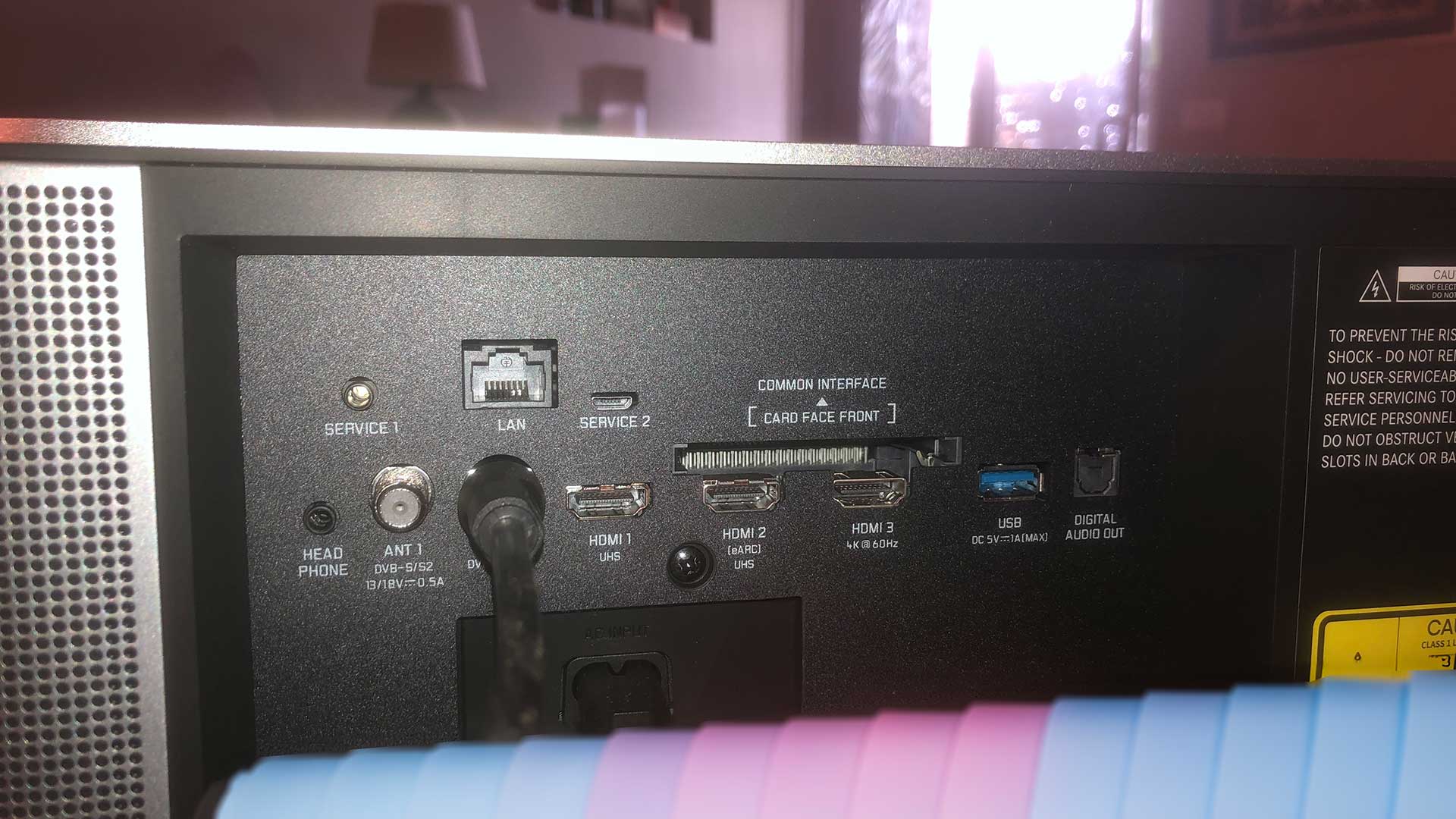
Build & facilities

Projection technology: TI 4K XPR DMD, triple laser
DMD: 0.47-inch, native resolution 1920x1080
Screen resolution: 4K UHD, 384 x2160
Light output: approx. 3000 lumens
HDR modes: HDR10+, HLG, Dolby Vision
Contrast ratio: ~1000:1
Dynamic contrast: ~2,000,000:1
Throw ratio: 0.25
Inputs: 3 x HDMI, 2 x USB-A, 2 x antenna in, tuner, AirPlay, Bluetooth, screen mirroring, Ethernet, Wi-Fi
Outputs: HDMI ARC, optical digital audio, minijack headphone out
Smart TV interface: VIDAA 6.0
Dimensions: 600 x 378 x 149 mm
Weight: 13.6kg
We must pause again to appreciate Leica’s gorgeous cabinet, which looks as stunning in the flesh as in pictures, its timeless style seeming entirely 21st century while still triggering thoughts of those Pradovits of the 1960s. They call it Bauhaus, but it’s more sophisticated than purely functional, the matte silver aluminium housing perforated as it wraps around front and sides all the way to the connections bay at the rear, allowing the speakers beneath to do their stuff at the front, while four fans allow cooling ventilation to operate at the sides.
The flat silver top surface is split in the middle and is closed as a dust cover when not in use, sliding open mechanically when you press the power button either at the front right of the top surface or on the remote control. Once open and the triple lasers activated, there is a proximity sensor which interrupts programming with a warning not to look into the lens, even counting down to an auto switch-off. As we were poking around the back more than most, we found this warning being triggered rather too frequently for our purposes, so we found an option in settings to turn off this safety feature. Use it with caution, subsequently, naturally.
That connections bay at the rear is generous (for a projector) with its three HDMI inputs, two of which are HDMI 2.1, one of which is HDMI 2.0 – so use the former for gaming, since it can receive above 4K/60. HDMI 2.1 is also officially compatible for Dolby Vision and HDR10+ High Dynamic Range with metadata, though these should work fine through HDMI 2.0 anyway.
More importantly one of the HDMI sockets (number 2) has eARC, the Audio Return Channel, so that you could use this path – or the provided optical audio output – to attach a sound system larger than the one built into the Cine 1.
Would you want to do that? Maybe. The sound system here is fairly capable, if something of a grey area in terms of specifications – there’s a mention of 2 × 25W, which might imply it’s straight two-channel, though it’s elsewhere termed a four-channel implementation, so there may be something going on with regard to the Atmos configuration. Peering through the grille with a torch reveals small side-firing 30mm drivers in addition to the two forward-facing drivers (and the four large fans in total down the two sides; these operate remarkably quietly).
Our guess would be that the configuration here is delivering primarily a virtual centre from the front and wider two-channel from those side drivers, along with an Atmos-compatible processor and some level of Dolby virtualisation. That would certainly match the characteristics of the sound that we heard emerging from the cabinet (see below).
Third option for the sound – there’s a minijack headphone socket, positioned rather inconveniently on the back; it would be better next to the USB 2.0 slot which is nicely accessible on the unit’s left side; there’s also a USB-A 3.0 slot at the rear. These can be used to power devices or for file playback, but also for recording from the TV antenna. So this is not only a projector, a TV and a sound system; it’s also a personal video recorder, though with limitations, as we’ll see.
There are usefully two antenna sockets at the back for your free-to-air TV broadcasts, one on the standard TV coax connector and one on BNC. There’s an Ethernet socket if you’re not using Wi-Fi, and two different service ports. There’s also a CI+ card slot round the back, which we gather is for non-Australian satellite usage.
The remote control is lovely; it is possibly plastic but it looks and rather feels like aluminium, with nice textured and raised buttons, and that red Leica circle below four dedicated buttons for Netflix, YouTube, Prime and Deezer. Odd to see Deezer there but these things are a combination of what the local market needs and who is happy to pay to get a button. Oh, and there’s a mini (maybe half-price) one for Disney+.
There’s voice control under a button here as well, and it was unusually effective; we find voice control on TV often unpredictable and best avoided during programming, as the wrong command can cancel everything and send you to YouTube. Here we could reliably call up inputs, streaming services, even single programmes. “Find Welcome To Wrexham”, for example, found the programme rather than setting off a Google or YouTube search for the town, as an Android TV might do.
And as we found, this remote control can operate current Hisense TVs, and vice versa.
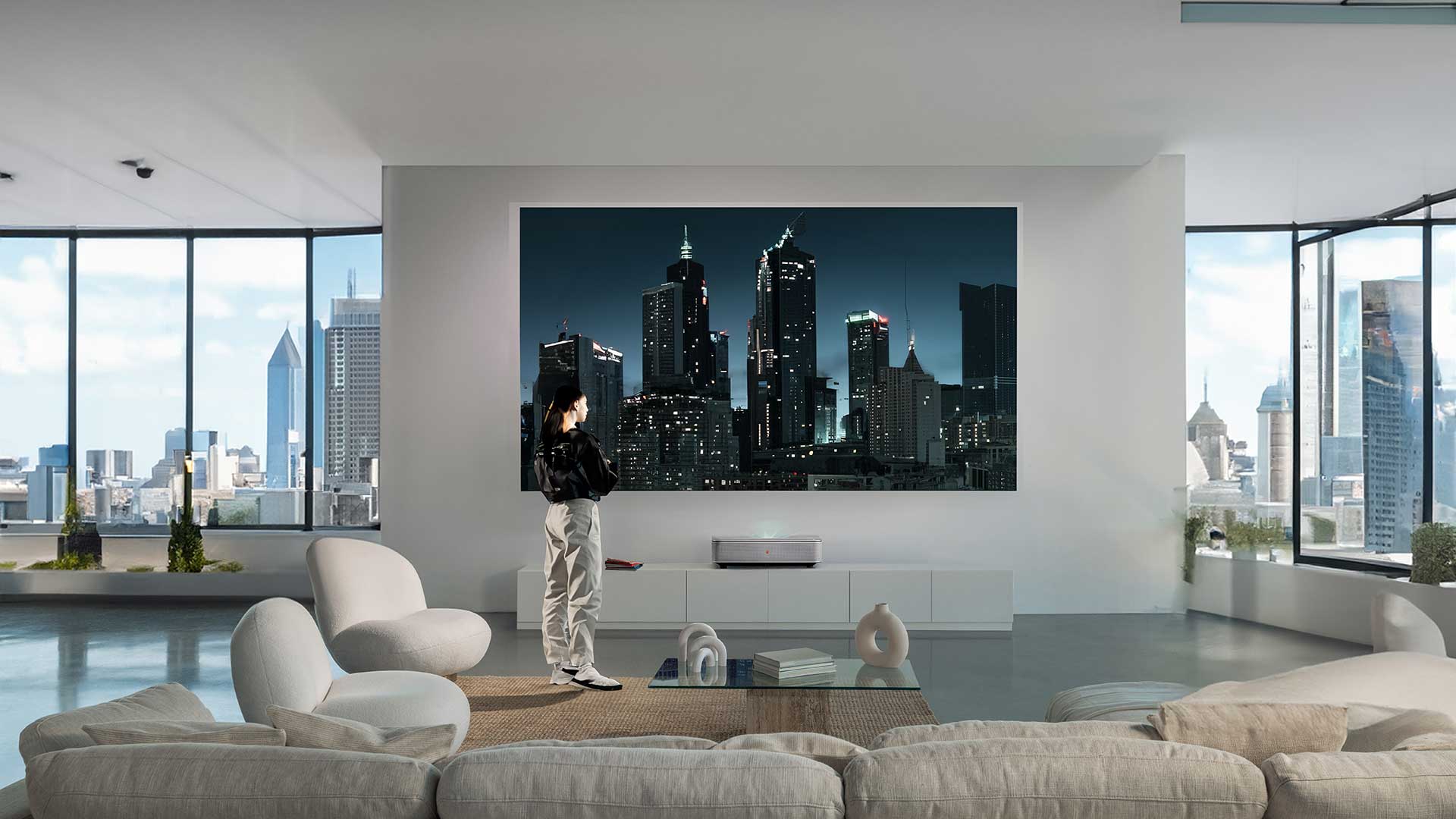
Setting up
We’ve covered some of the setting up: position the projector to establish the screen position, then install the screen, and carefully tweak the projector position physically, before using either the manual or auto geometric correction options, if you need them at all.
As with all ultra-short-throws, you’ll find that to fill the 100-inch diagonal screen, you’ll need the projector body surprisingly far out into the room. In our case the back of the Leica was about 28cm from the wall, leaving the front a full 65cm out; the more important measurement may be for its front feet, since they need to be on your benchtop – they are some 60cm from your wall, so you need at least that depth of bench.
That’s pretty deep – go measure your own TV bench now. So you could do what we do and have it on a sturdy moveable stand, rather as we did our Leitz Pradovit slide projector back in the day, but here much closer to the wall. (Note that we’ve seen Leica set-up literature with error in the numbers putting the back of the Cine 1 at 37cm from the wall; this could only be right if the projector is 26cm deep, and it isn’t.)
Ultra-short-throw projectors commonly suffer from the ‘bump’ effect – not the bumps that exist on rendered walls, though USTs certainly suffer from those being accentuated from a light source below, which is why a screen is so important with UST designs.
No, it’s that they stick out so far into the room that people can bump into them, and their alignment is then thrown all off. This is quite a pain with carefully-aligned ultra-short-throws, but unusually we found it extremely easy here to resquare the image on the screen compared with previous ultra-short-throws we’ve tested. When speaking to Leica they seemed to think that positioning was tricky, hence they have an installation service available in Sydney, Melbourne and Brisbane and through dealers elsewhere. For putting that screen together and mounting it, we’d certainly be considering paying for the professionals. But getting the Cine 1 itself into position we found so easy that we took to sliding it out of the way on its trolley during periods it wasn’t in use.
We thought perhaps this was made easier by the Leica’s relatively large size, but also, we decided, because the image here is straighter than from any other ultra-short-throw we’ve used. That upfiring geometry is so hard that the top of the picture from a UST projector is invariably slightly curved compared with a longer-throw projector, and often even in the middle area, so that a long pan across country-side say, can have a slightly nauseating bulge as it moves. Here we could see none of that, only the slightest curve to the top line of illumination, invisible behind screen masking.
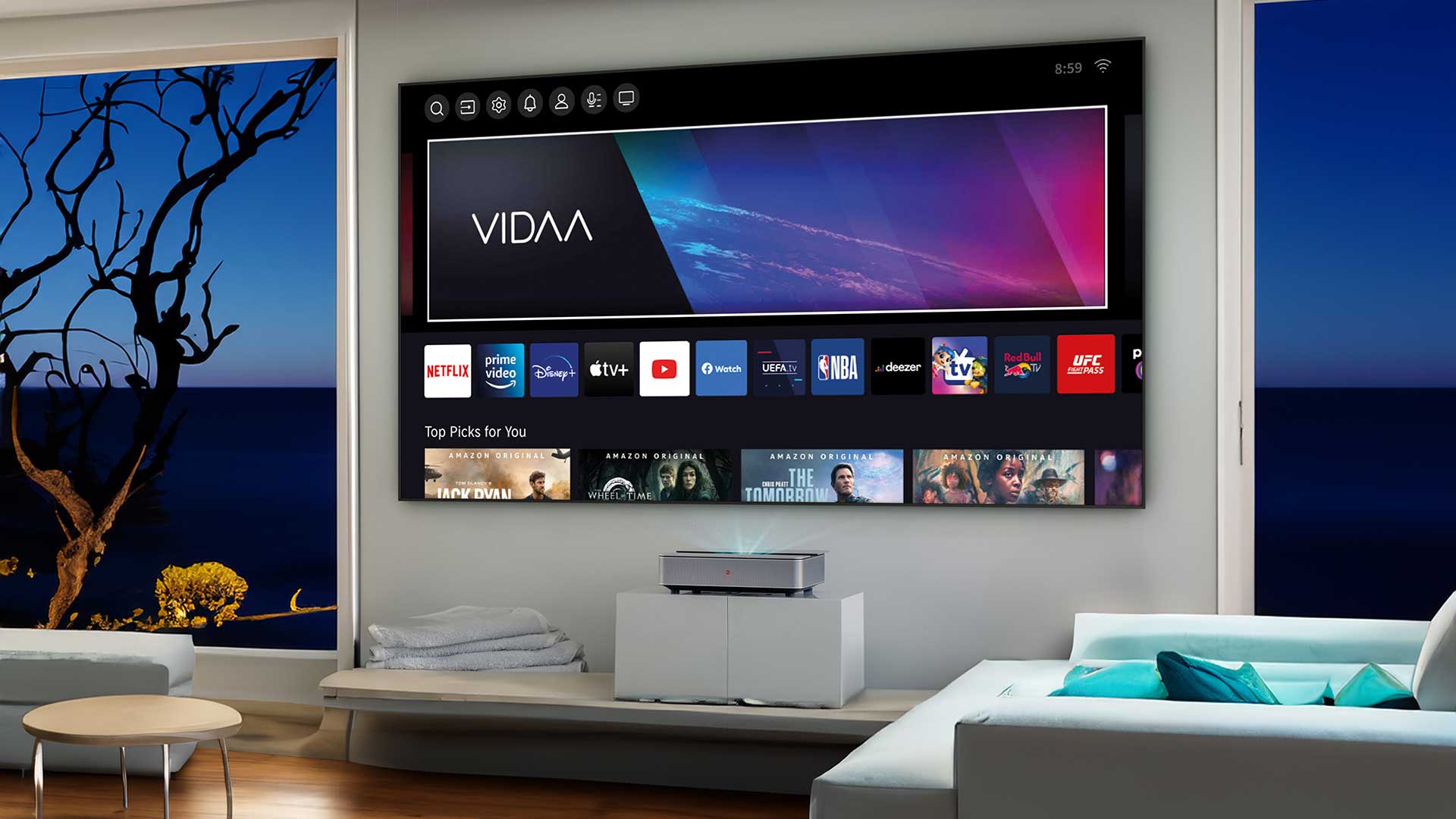
Smart TV
So, easy enough to get back in position, and for those using the Cine 1 as a TV replacement, chances are that the projection unit and its screen will be in more constant use, and won’t be going anywhere. This is, remember, a fully smart TV, with TV tuner and networking for its smart operating system. As noted the operating system and user interface is VIDAA, as used in Hisense’s Laser TVs and televisions, and other than the menus to control the actual projector functions, this 6.0 version of VIDAA seems identical as in the latest Hisense TVs. Which is no bad thing, as VIDAA is a very good interface, attractive and clear. Its main screen keeps physical inputs away under a virtual or remote button, while the top third of the initial screen offers a two-pane choice of ‘VIDAA Free’ or VIDAA App store.
‘VIDAA Free’ is something rather less than the ‘free’ content served by competitors such as TCL and Samsung, or by Hisense itself on its own TVs. During our use this section simply collated some recommendations of content from Tubi, ABC, Plex and, er, ‘Toon Goggles’, and only a total of 81 titles in all. The free ‘live’ channels you get on a VIDAA Hisense TV seemed not to be available.
So for content you’re far better off surfing the many many apps to which VIDAA app store gives access. Some are preloaded, others you’ll need to search and install. There are four of the five network catch-up apps – ABC, SBS, 9 and 10, but not 7play. And there’s pretty much every streaming service except Binge, Kayo and Foxtel (who we gather wouldn’t extend VIDAA’s licence for these services to a third-party user, perhaps why the live VIDAA Free channels are also absent – which is curious, really, since VIDAA often proclaims its pseudo-independence from Hisense, and that should make Hisense a third-party user too).
Workarounds for those missing services? When we searched the app store for Binge, VIDAA instead offered instead a web browser which we thought might just work for streaming – but we couldn’t find out, as the onscreen keyboard didn’t include the ‘!’ required for us to enter our Binge password.
Your other option for content is to stream it across; there’s AirPlay available for one, which can be used for screen mirroring from a Mac. This worked great for our own videos and YouTube; rather annoyingly Binge, like Netflix, seems to block AirPlay video streaming of its shows as soon as we started, so there are limitations here too.
All such limitations can be surmounted simply by plugging in your laptop (or a media player) via HDMI. HDMI will also provide top-level visuals and sound from, say, 4K Blu-ray, so we attached a Panasonic 4K Blu-ray player to the Cine 1 and settled back for some serious viewing time.
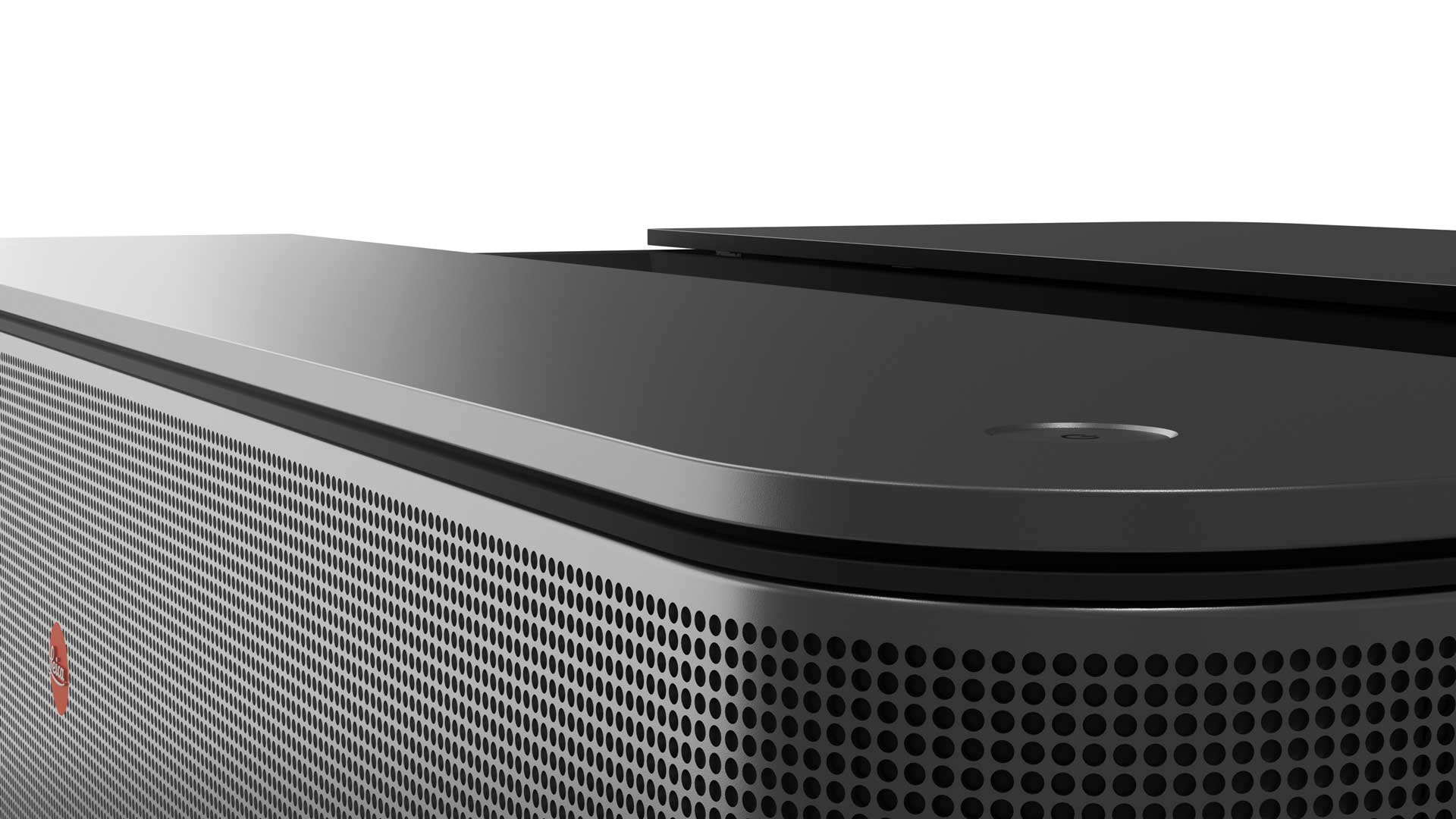
Viewing & listening
This is one of the larger ultra-short-throw projectors to have come through our test room, and we have never had one so able to banish ambient light effectively. This is assisted by the ambient-light-rejecting screen, but is also down to the projector’s inherent brightness, and perhaps the lack of loss through those higher quality lenses. We used it with a standard 100-inch screen as well, and between screens we found that even straight on the wall it still had enough in the way of illumination to deliver a fully bright cricket match (Australia v. Afghanistan) even with a good deal of diffuse ambient light in the room.
We had attached our roof antenna and set the Leica off on a scan of our free-to-air – just a little slower than average, to find 39 channels and 21 radio stations. The free-to-air channels defaulted to ‘Cinema’ picture modes, which have a useful choice of Cinema Day and Cinema Night, depending on your circumstance, and again the brightness was enough to deliver day-time TV more than watchably, though not, obviously, with the contrast you enjoy in a darker room, let alone that of a TV screen. This is just as well, since the fixed and UST nature of this projector means you can’t do the normal projector thing of bringing it closer to get a smaller brighter image when it’s not bright enough during the day.
To make a comparison with previous reviews, in this room we find the ambient light, when unblocked-off, to defeat most 3000 lumen projectors until near-dusk. The Leica was fine to deliver an image at midday with anything less than direct sunlight on the screen. We could leave Pointless running in the background as we worked and occasionally glance up in amazement at the vastness of Richard Osman on the 100-inch screen.
This ability to deliver during daylight is a huge advantage for a product which is positioning itself as an alternative to a TV rather than being a ‘special event’ projector. Most UST rivals fall short on this crucial criterion, nor have TV tuners built-in to make casual daytime viewing a possibility.
During those daylight hours the projector inevitably loses something in contrast and colour to a good television. But it gains vastly in the size of its presentation. Breakfast TV is enormous. True crime shows are downright alarming. The impact of Oliver Stone’s JFK Revisited, streaming from SBSOnDemand, is only magnified by such, er, magnification.
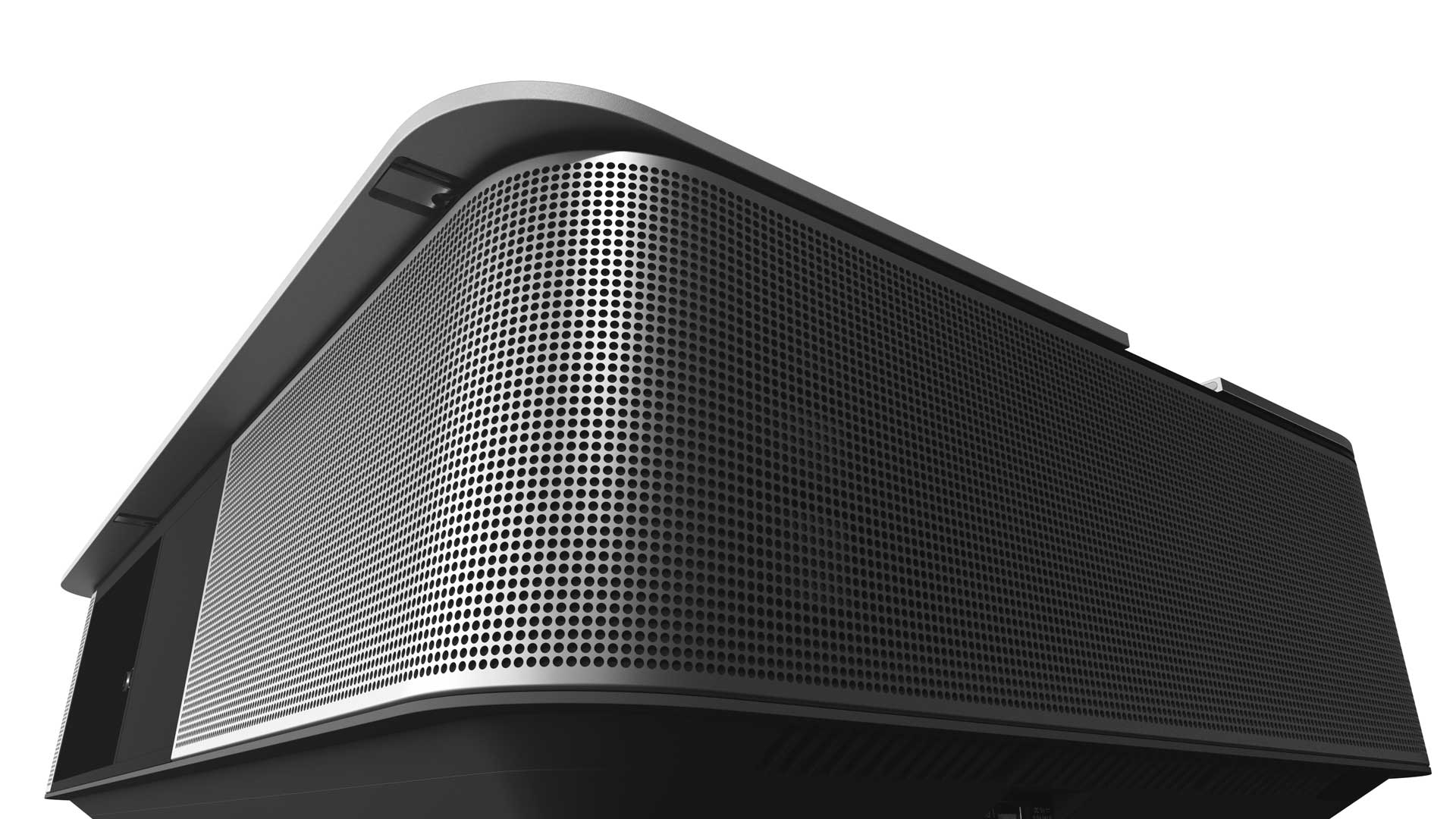
Especially once the day fades. Definition and clarity are then exceptional, no doubt again assisted by the quality of Leica’s glass. Menus are as laser sharp as the light source suggests, and when we plugged our demo 4K images into the USB-A slot, the DLP four-flip process of XLR seemed to be revealing perfect sharpness down to a two-pixel level for 4K and an impression of single pixel resolution, with seemingly zero misalignment between colours here nor, as noted, any dearth of brightness from the time segmentation of the four pixel positions.
Most impressive of all here, perhaps, was that the separation of two pixel lines remained equally clear all the way to the corners of the test image, a real sign of the quality of Leica’s lenses. The black test slides also showed no notable greying out of blacks anywhere on screen. In a darkened room, black bars above the movie should seem perceptually full black.
Such attributes yield simply beautiful images. National Geographic’s Secret of the Elephants (Disney+, 4K, Dolby Vision, 5.1) is full of thrilling photography across five different elephant habitats, and it expands magnificently to the big screen through Leica’s Cine 1. Bright but realistic forest greens, the deep detail in textures of elephant skin, the ability to see details even in shadows, and the impact from the screen size (near-lifesize elephants!) took this great doco series to the next level.
Going back to free-to-air TV, we did try the recording onto USB. This is not detailed in the manual, so you’re on your own, and it’s confusing, because you’re encouraged to use the green key to pop up the full Freeview Plus guide, which is indeed good for picking a show, if a little crude in appearance.
But this guide doesn’t let you record anything. Instead you need to press the remote’s ‘Guide’ key for an entirely different programme guide, with a cleaner if less colour-splashed layout, from which you can indeed record to a stick of your choice. From the literature, this should be a triple tuner, able to potentially record two networks other than the one you’re watching. But we found it allowed only one recording at once, showing a clash when we tried a second overlapping recording, and switching channels just prior to a recording. That indicated a single tuner, not a triple, which came as a surprise to Leica Australia, but they have confirmed that our Australian model seems to have been given one tuner not three, perhaps because of our unique Australian broadcast requirements.
The PVR otherwise worked reliably, though there’s no ‘series record’ options and no way we could find to delete recordings once made, other than pulling out the USB stick and doing the job with a computer instead. So if you really want a fully-functioning PVR, we’d suggest attaching something along the lines of a FetchTV.
Whatever the configuration of that sound system, it did well, and its Dolby Atmos compatibility did seem worth having. The first soundtrack which really burst to life was the first disc we played from a physically-connected 4K Blu-ray player. Paddington 2 (on 4K Blu-ray) proved a delight both visually and sonically. If the sound system here is indeed two-channel only then it did an extraordinary job of providing crisp central stuff for dialogue and effects — for the bear and his banging bucket, say — while delivering the music soundtrack entirely separately in a wider soundstage of some depth.
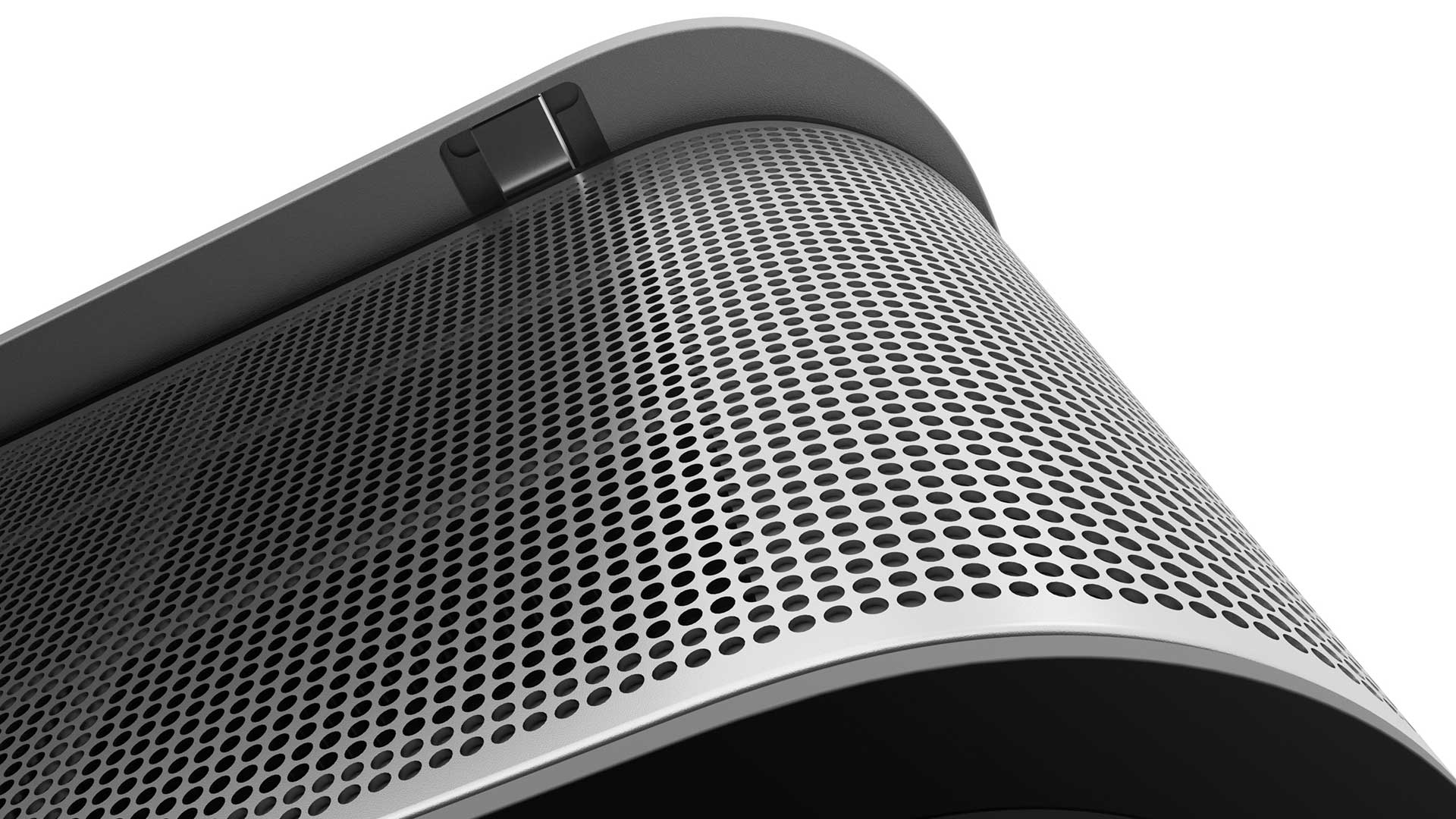
There are sound modes available for selection. ‘Theatre’ bigs things up best, and can at times spread things remarkably wide: witness the moment of imagined applause for Hugh Grant 26 minutes into Paddington 2, achieving remarkable immersion here without the slightest loss of dialogue intelligibility.
The degree to which you can fully appreciate these effects will depend on your room; they are best appreciated fairly close up and immediately in front of the projector; obviously those seated to either side will enjoy increasingly less stereo effect. The clarity and separation also softens with room effect as you sit further back, and there are limits of slight compression if you take it up to higher levels; things can get shouty. But it’s comfortable up to enjoyably full levels, and Atmos soundtracks have even more clarity; just don’t ask too much. Lesser soundtracks, of course, sound less well separated, and can even get a little boxy; switching to a less bassy sound mode can clarify this.
Overall the sound is far better than almost any flatscreen TV will give you, and the match of most mid-price soundbars. Looking at the space available for the sound system – really just the front few inches of the chassis – it’s as effective and room-filling as you could expect. This is perhaps one area that might be developed further in a premium all-in-one product like this, to create something equally special in the sonics as on the screen. Imagine if Wetzlar spoke to Wedemark or Erlangen, so that Leica’s optics were combined with Sennheiser’s Ambeo or Fraunhofer’s upHear. Leica does call this a ‘Cinema TV’ after all, and big sound is a big part of real cinema.
So there’s still room for a sonic upgrade to a full-scale stereo or surround sound system here, which would more magnificently support the excellent bigscreen images here.
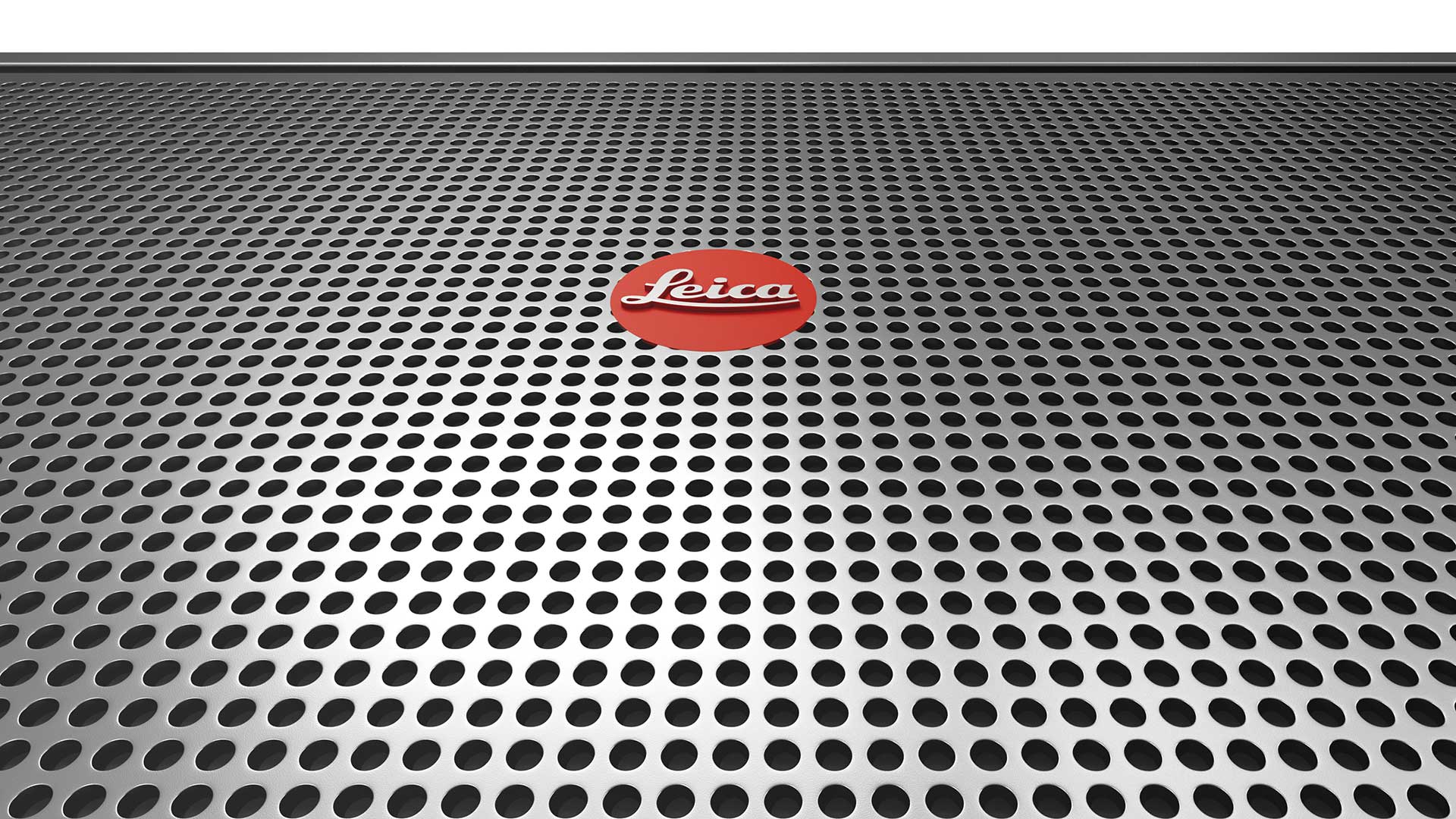
Because visually, too, Paddington 2 was a feast of detail, colour and motion. Such detail! – Paddington’s own ever ruffling fur is artfully animated and detailed, but so are real-life elements like the grey straw hair seemingly plonked on Julie Walters’ head during a reaction shot in the courtroom, the softness of her fluffy beige hat leaping out, with two clockwise-woven braids in colours both strong and accurate, not to mention Walters’ finely etched (and not-too-craggy) skin tone or her deep purple bathrobe jacket with slight wear-marks visible on its thick pile.
This 4K Blu-ray also delivers Dolby Vision High Dynamic Range, and this had triggered the Cine 1’s Dolby Vision picture modes automatically. There are several Dolby Vision presets and customisation available, so we brought colours out of any shift to warm back to neutral, and reduced the Ultra Smooth Motion setting to just ‘smooth’, which was enough to entirely eliminate a slight frame judder when this setting was entirely off. There are many motion challenges in Paddington 2 – the water in the muddy river of the opening, the fence railings as he cycles around Windsor Gardens, the barbershop sequence, the window cleaning: it’s like a demo disc with a plot. The processing here passed muster almost every time – just those pesky fence railings we couldn’t stop strobing a little in the background even when we manually tweaked the deblur and dejudder settings individually. There are auto and force-video settings available in the menus here, though no force-film mode.
Leaving discs behind, we switched to the internal smart VIDAA interface to watch examples from the streaming apps. Disney+ programming with Dolbies Vision and Atmos proved similarly impressive. We rewatched chunks of Get Back, marvelling again at the quality obtained by Peter Jackson’s team from the original 16mm footage. We watched the finale of Welcome To Wrexham S02 twice on this system, the handheld match footage almost disorientating when writ so large, but the interview headshots rendered with every pockmark and eyebrow hair sharp, every detail in that extraordinary celebratory street parade captured for the record – and all this even though the show is only HD, not 4K (a reminder that 2K is not so very far behind 4K in most circumstances).
One setting we liked very much – as soon as you press the ‘menu’ button on the remote, the top option is ‘Audio Only’, which blanks the screen to deliver audio only. (The screen comes back on as soon as you press another button.) For those who like playing music through apps on their smart TV, this is a huge boon, allowing you to enjoy the music without a screen blazing away. Sometimes even the best screens need to be turned off.

Verdict
The consumer ultra-short-throw projector category came of age once they were reimagined as a TV replacement, with streaming dongles and built-in speakers. Hisense took the idea to another level with its Laser TVs, and now Leica has taken those Laser TVs to another level, principally by upgrading the lenses, but also the look, creating a premium product which we reckon will attract higher-end buyers as much with its product design, which is so gorgeous, as with its performance, which is pretty thrilling, even overcoming a good whack of ambient light, though reaching its ultimate best in a darker room.
The VIDAA interface is excellent; the laser light source boasts 25,000 hours of service life; the whole thing seems to use less power than a comparable TV, and yet you get the best and brightest ultra-short-throw image we’ve yet seen. What’s not to like? The PVR section was the only bit which disappointed
And as for the price, well, it’s no secret that good lenses are not cheap. Plus the thing looks like an instant design icon, and it’s the best we know of in its category, and hey – it’s a Leica.
One last thing: remember that Pradovit slide projector we grew up with in the 1970s? We had it out recently, and it’s still working (below!). So besides the company’s preeminence and prestige, you can hopefully look forward to a long future for all that rolling entertainment up there above the Cine 1’s red Leica dot, providing long-term immersion for your movies, streaming, gaming, even Pointless, all writ large up there on the big Leica screen.
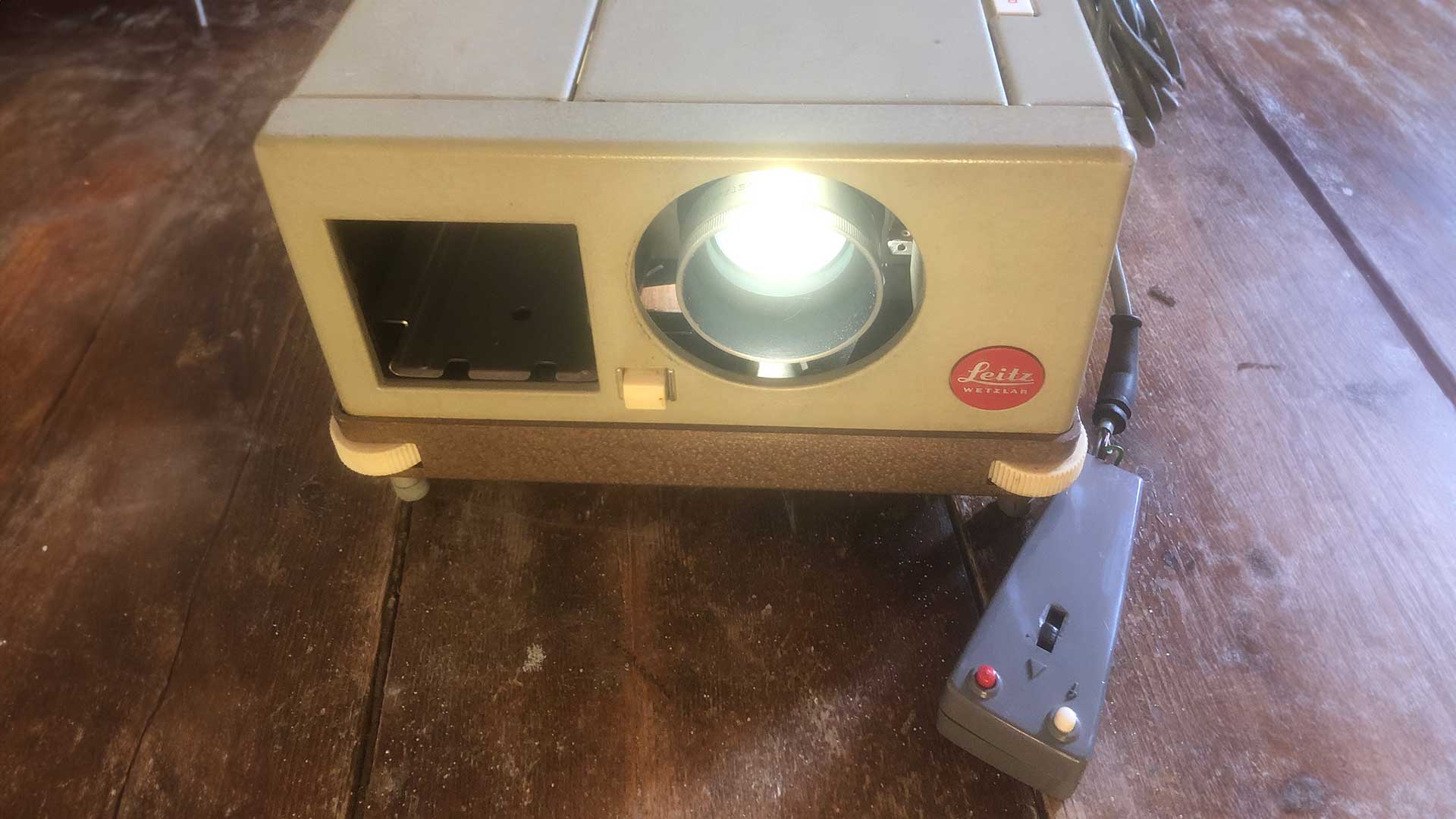

Jez is the Editor of Sound+Image magazine, having inhabited that role since 2006, more or less a lustrum after departing his UK homeland to adopt an additional nationality under the more favourable climes and skies of Australia. Prior to his desertion he was Editor of the UK's Stuff magazine, and before that Editor of What Hi-Fi? magazine, and before that of the erstwhile Audiophile magazine and of Electronics Today International. He makes music as well as enjoying it, is alarmingly wedded to the notion that Led Zeppelin remains the highest point of rock'n'roll yet attained, though remains willing to assess modern pretenders. He lives in a modest shack on Sydney's Northern Beaches with his Canadian wife Deanna, a rescue greyhound called Jewels, and an assortment of changing wildlife under care. If you're seeking his articles by clicking this profile, you'll see far more of them by switching to the Australian version of WHF.
